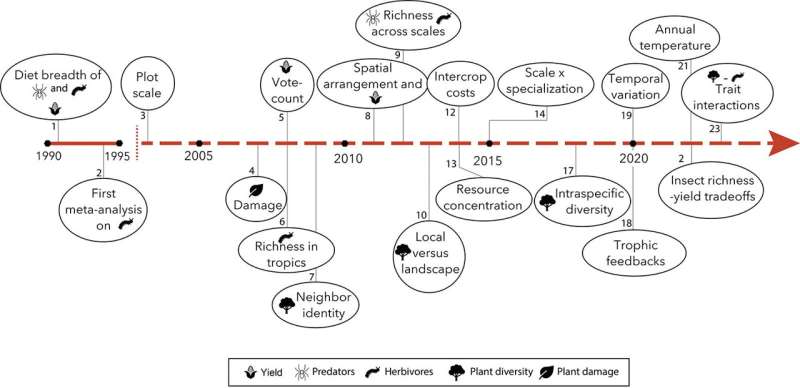This article has been reviewed according to Science X's editorial process and policies. Editors have highlighted the following attributes while ensuring the content's credibility:
fact-checked
peer-reviewed publication
trusted source
proofread
Working towards better recommendations for how biodiversity may be leveraged to promote delivery of ecosystem services

Thousands of studies examine how plant diversity structures predator communities and shapes herbivore pressure. This body of evidence has led to at least 23 separate quantitative syntheses encompassing a wide range of approaches to understanding plant diversity effects. Yet the sheer quantity of primary literature and inconsistency among these syntheses prevents a confident understanding of consensus in plant diversity outcomes.
"A Guide to 23 Global Syntheses of Plant Diversity Effects: Unpacking Consensus and Incongruence across Tropic Levels," a new paper published in The Quarterly Review of Biology, scrutinizes these 23 quantitative syntheses published over three decades on how plant diversity impacts both natural enemies and herbivores in arthropod communities and scrutinizes their divergent patterns to identify key drivers of herbivory.
Amid the 23 syntheses, robust patterns have stood the test of time: divergent outcomes frequently result from insect diet breadth, spatial scale, and plant relatedness variation. "Clarifying these persistent drivers enables us to identify and explore remaining sources of variation in plant diversity effects across trophic levels," note authors K. D. Holmes and C. K. Blubaugh.
They find that plant diversity consistently attracts more abundant and diverse communities of predators. Herbivore diversity tends to increase in response to plant diversity treatments, while herbivore abundance and plant damage generally decrease. However, these net effects often mask nuanced responses to plant diversity that depend on ecosystem, scale, and specialization. For instance, specialist herbivores often respond negatively to plant diversity, while generalists more often mount positive or neutral responses.
The authors conduct a historical review of the past three decades of syntheses, reporting their approaches, scopes, and findings across trophic levels. They examine core ecological variables that shape the varying outcomes across studies, identify consistent patterns across these ecological factors, and explore mechanisms that explain incongruence between syntheses. Finally, they discuss the complex species interactions and analytical approaches that will be key in resolving context dependency and improving the ability to predict reliably whether biodiversity functions or fails to deliver ecosystem services.
The authors also present a chronological and conceptual history of the 23 meta-analyses and global syntheses of plant diversity effects, focusing on major developments in this literature, and interpret outcomes for the most commonly reported responses of arthropods and plants, principally, the abundance and species richness of herbivores and predators and productivity and damage in plants.
Spatial context is key to understanding impacts of diversity at different trophic levels. Studies conducted at greater spatial scales often show a dilution of effects on herbivores but reveal conflicting effects on predators. Plant arrangement is also important, with agricultural studies showing that alternating rows of crops reduces pest populations, while surrounding crop fields with floral borders better supports predators.
Meanwhile, research in forests has demonstrated that the arrangement of plant diversity interacts with other elements of plant and herbivore natural history, such as insect diet breadth and plant relatedness, to predict outcomes. Despite the complexity of outcomes, syntheses show that diversifying plant communities hold great promise for enhancing the resilience of managed ecosystems.
The plethora of syntheses on plant diversity effects reflects the challenge of understanding relationships in complex multitrophic communities, an urgent need for improved predictability in biodiversity-based tools for pest control in agroecosystems, and the rapidly expanding literature. Despite achievements in research and synthesis, the sheer number of meta-analyses with conflicting results means that outcomes of plant diversity for herbivorous insects are not generalizable.
"Scrutinizing potential mechanisms underlying variation in outcomes across meta-analyses is vital," the authors write, "especially now as 'meta-meta-analyses' have begun to emerge from this explosive body of work that further pool and simplify results."
By distilling the varied results of the 23 syntheses, the authors pave the way for stronger and more precise recommendations for how biodiversity may be most effectively leveraged to promote delivery of ecosystem services.
"Fine-tuning management of biodiversity will be essential to meet the ever-growing global need to design sustainable agriculture solutions that support both high plant productivity and diverse plant-arthropod communities," they note.
More information: K. D. Holmes et al, A Guide to 23 Global Syntheses of Plant Diversity Effects: Unpacking Consensus and Incongruence across Trophic Levels, The Quarterly Review of Biology (2023). DOI: 10.1086/726687
Journal information: Quarterly Review of Biology
Provided by University of Chicago

















